Identification and characterization of the locus for diffuse adherence, which encodes a novel afimbrial adhesin found in atypical enteropathogenic Escherichia coli
- PMID: 16040988
- PMCID: PMC1201181
- DOI: 10.1128/IAI.73.8.4753-4765.2005
Identification and characterization of the locus for diffuse adherence, which encodes a novel afimbrial adhesin found in atypical enteropathogenic Escherichia coli
Abstract
The O26 serogroup of enteropathogenic Escherichia coli (EPEC) is one of the serogroups most frequently implicated in infant diarrhea and is also common among enterohemorrhagic E. coli (EHEC) strains. The most common O26 strains belong to EPEC/EHEC serotype O26:H11 and are generally Shiga toxin (Stx) positive. Stx-negative E. coli strains that are negative for the EPEC EAF plasmid and bundle-forming pilus (Bfp) are classified as atypical EPEC. Here, we report a novel adhesin present in an stx-negative bfpA-negative atypical EPEC O26:H11 strain isolated from an infant with diarrhea. A cloned 15-kb genomic region from this strain, designated the locus for diffuse adherence (lda), confers diffuse adherence on HEp-2 cells when expressed in E. coli K-12. Sequence analysis of lda revealed a G+C content of 46.8% and 15 open reading frames sharing homology with the E. coli K88 fae and CS31A clp fimbrial operons. The lda region is part of a putative 26-kb genomic island inserted into the proP gene of the E. coli chromosome. Hybridization studies have demonstrated the prevalence of the minor structural subunit gene, ldaH, across E. coli serogroups O5, O26, O111, and O145. A second plasmid-encoded factor that contributed to the Hep-2 adherence of this strain was also identified but was not characterized. Null mutations that abolish adherence to HEp-2 cells can be restored by plasmid complementation. Antiserum raised against the major structural subunit, LdaG, recognizes a 25-kDa protein from crude heat-extracted protein preparations and inhibits the adherence of the E. coli DH5alpha lda(+) clone to HEp-2 cells. Electron microscopy revealed a nonfimbrial structure surrounding the bacterial cell.
Figures
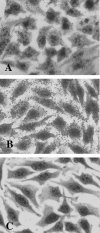




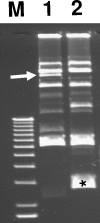
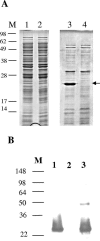
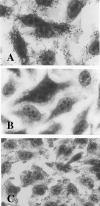
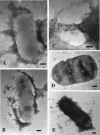
Similar articles
-
A plasmid-encoded type IV fimbrial gene of enteropathogenic Escherichia coli associated with localized adherence.Mol Microbiol. 1992 Nov;6(22):3427-37. doi: 10.1111/j.1365-2958.1992.tb02210.x. Mol Microbiol. 1992. PMID: 1362446
-
Bile salts induce expression of the afimbrial LDA adhesin of atypical enteropathogenic Escherichia coli.Cell Microbiol. 2007 Apr;9(4):1039-49. doi: 10.1111/j.1462-5822.2006.00850.x. Cell Microbiol. 2007. PMID: 17381433
-
Molecular and phenotypic characterization of atypical enteropathogenic Escherichia coli serotypes isolated from children with and without diarrhea.J Microbiol Immunol Infect. 2011 Feb;44(1):27-32. doi: 10.1016/j.jmii.2011.01.006. Epub 2011 Jan 12. J Microbiol Immunol Infect. 2011. PMID: 21531349
-
AFA and F17 adhesins produced by pathogenic Escherichia coli strains in domestic animals.Vet Res. 1999 Mar-Jun;30(2-3):317-42. Vet Res. 1999. PMID: 10367361 Review.
-
[Genes involved in the virulence of enterohemorrhagic Escherichia coli].Nihon Rinsho. 1997 Mar;55(3):641-5. Nihon Rinsho. 1997. PMID: 9086773 Review. Japanese.
Cited by
-
Putative adhesins of enteropathogenic and enterohemorrhagic Escherichia coli of serogroup O26 isolated from humans and cattle.J Clin Microbiol. 2009 Jul;47(7):2090-6. doi: 10.1128/JCM.02048-08. Epub 2009 Apr 29. J Clin Microbiol. 2009. PMID: 19403767 Free PMC article.
-
EPEC autotransporter adhesin (Eaa): a novel adhesin identified in atypical enteropathogenic Escherichia coli.Front Cell Infect Microbiol. 2025 Aug 18;15:1617101. doi: 10.3389/fcimb.2025.1617101. eCollection 2025. Front Cell Infect Microbiol. 2025. PMID: 40900999 Free PMC article.
-
Dissection of the role of pili and type 2 and 3 secretion systems in adherence and biofilm formation of an atypical enteropathogenic Escherichia coli strain.Infect Immun. 2013 Oct;81(10):3793-802. doi: 10.1128/IAI.00620-13. Epub 2013 Jul 29. Infect Immun. 2013. PMID: 23897608 Free PMC article.
-
Quantitative analysis and virulence phenotypes of atypical enteropathogenic Escherichia coli (EPEC) acquired from diarrheal stool samples from a Midwest US hospital.Gut Microbes. 2020 Nov 9;12(1):1-21. doi: 10.1080/19490976.2020.1824562. Gut Microbes. 2020. PMID: 33131419 Free PMC article.
-
The Mobilome; A Major Contributor to Escherichia coli stx2-Positive O26:H11 Strains Intra-Serotype Diversity.Front Microbiol. 2017 Sep 6;8:1625. doi: 10.3389/fmicb.2017.01625. eCollection 2017. Front Microbiol. 2017. PMID: 28932209 Free PMC article.
References
-
- Adams, L. M., C. P. Simmons, L. Rezmann, R. A. Strugnell, and R. M. Robins-Browne. 1997. Identification and characterization of a K88- and CS31A-like operon of a rabbit enteropathogenic Escherichia coli strain which encodes fimbriae involved in the colonization of rabbit intestine. Infect. Immun. 65:5222-5230. - PMC - PubMed
-
- Afset, J. E., K. Bergh, and L. Bevanger. 2003. High prevalence of atypical enteropathogenic Escherichia coli (EPEC) in Norwegian children with diarrhoea. J. Med. Microbiol. 52:1015-1019. - PubMed
-
- Alexeyev, M. F., I. N. Shokolenko, and T. P. Croughan. 1995. New mini-Tn5 derivatives for insertion mutagenesis and genetic engineering in Gram-negative bacteria. Can. J. Microbiol. 41:1053-1055. - PubMed
-
- Bakker, D., C. E. Vader, B. Roosendaal, F. R. Mooi, B. Oudega, and F. K. de Graaf. 1991. Structure and function of periplasmic chaperone-like proteins involved in the biosynthesis of K88 and K99 fimbriae in enterotoxigenic Escherichia coli. Mol. Microbiol. 5:875-886. - PubMed
Publication types
MeSH terms
Substances
Associated data
- Actions
Grants and funding
LinkOut - more resources
Full Text Sources
Miscellaneous

